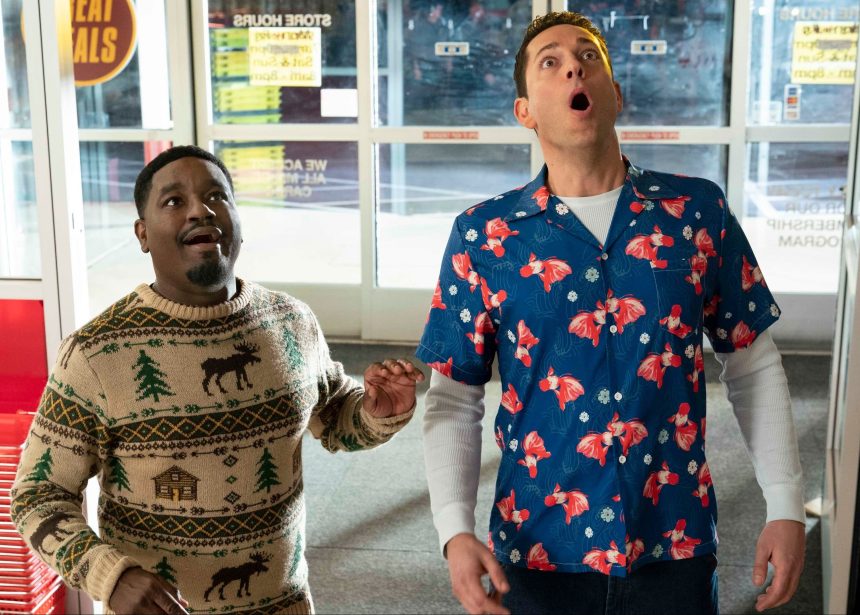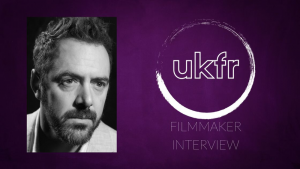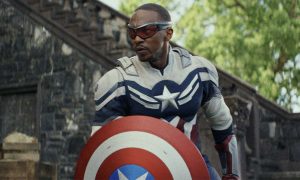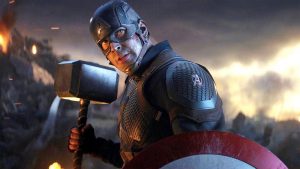
AGGRESSIVELY MEDIOCRE AND
TERRIBLY HALF-BAKED
In the world of literary works and the realm of the written word, children’s picture books have found a special place in enjoyment and appreciation. While may be overlooked as simplistic tales for bedtime stories for children or for the “juice box” age range to engage in reading, children’s picture books can depict such potent imagery with its illustrations, while also appealing to a small (yet effective) narrative that can grab a reader’s attention and quickly get out in an instant. Given such potential in such a niche area of children’s literary, Hollywood has found some attractiveness towards children’s picture books, taking the simple stories and expanding upon by fleshing out more details about the story and characters, while also interjecting new ideas and themes. Such prime examples of this “book to film” adaptations can be found a wide variety of movie projects, including 1995’s Jumanji, 2003’s The Cat in the Hat, 2004’s The Polar Express, 2009’s Cloudy with a Chance for Meatballs, 2009’s Where the Wild Things Are, 2012’s The Lorax, 2015’s Paddington, and 2022’s Lyle, Lyle Crocodile just to name a few. Now, Sony / Columbia Pictures and director Carlos Saldanha present the latest film adaptation of a children’s picture book with the release of Harold and the Purple Crayon, based on the 1955 book of the same name by author Crockett Johnson. Does this movie warrant a glance from viewer of this well-known children’s picture book or is it slap-dash mess of the feature that lacks cinematic integrity and creative imagination?
THE STORY
Harold (Zachary Levi) has grown up and lives within the delightful comfort of his fantasy world, with a magical purple crayon to bring anything he can imagine to life. Harold is not alone, however, joined with close longtime pals Moose (Lil Rel Howery) and Porcupine (Tanya Reynolds), while having guidance from the Old Man (Alfred Molina), an unseen narrator of Harold’s world. When Old Man’s voice disappears one day, Harold is inspired to visit where narrator comes from….the Real World, seeking him out in a way to learn more about the unseen man. Drawing a portal with his crayon, Harold arrives in the big city, with Moose and Porcupine trailing after him. While dazzled and curious by all he finds in the world of reality, Harold is having a difficult time adjusting to world, making a sudden connection with single mother Terri (Zooey Deschanel) and her son, Mel (Benjamin Bottani), but is still determined to locate the Old Man and his whereabouts, even though he has no idea where to start. As Harold works with the crayon to help Terri and Mel with their own personal problems in their lives, while also getting into mischief tomfoolery along the way, librarian Gary (Jemaine Clement) notices the magical crayon in play, inspired to steal the drawing tool and bring his own fantasy world to life.
THE GOOD / THE BAD
As I’ve stated several times in some of my reviews, Hollywood has always circled back around to literary world of novels and books for inspiration, with a bountiful sea of authors and stories to pick from for a potential cinematic adaptation. Working at bookstore for more than a decade and half, I was quite versed in many titles and authors from various genres and still am. The bookstore’s kid’s section, especially the children’s picture books area, saw numerous of titles both classic and new ones were always stacked and definitely have a certain charm to them. Naturally, the marriage of between these particular type of books with “page to screen” adaptation is abundantly clear from Hollywood, with many studios buying the rights up for a full motion picture that (as mentioned above) expands on the simple narrative to provide a better context for its story, plot, characters, and overall themes in either a live-action adaptation or animated presentation. Like all “books to film” adaptations, not all are created equal or well-received, with some having mediocre results and opinions on that I’ve seeing include 2003’s The Cat in the Hat, 2014’s Alexander and the Terrible, Horrible, No Good, Very Bad Day, and 2012’s The Lorax. The Lorax in particular was good, but all the new additional material beyond the core story was pretty forgetful and “meh”, which is disappointing because I do love Dr. Seuss’s beloved tale. On the flip side, there have been plenty of other films in this endeavor that have found success and have become memorable with many throughout the years, with some of my favorite include 1995’s Jumanji (loved watching this movie all the time at my grandparents), 2004’s The Polar Express (a great holiday movie for me and…. the bell still rings for me). and 2015’s Paddington (I mean….who couldn’t help to love such a polite and clumsy bear). There have been several other projects that fit into these categories (and some in-between), but you get the idea. In the end, while Hollywood studios will continue to seek out source material in the literary realm, children’s picture books film adaptations, while not as widely popular as adult novel adaptations, still find a special place to warm a viewer’s heart, recalling old familiar stories and characters into a new theatrical medium.
This brings me back around to talking about my Harold and the Purple Crayon (2024) review, a kid’s fantasy / comedy presentation and the latest film to be adapted from a children’s picture book. While I did work in a bookstore for years as well as shelving / selling various books within this section, I actually never sat down and read Johnson 1955 story. I remember quickly looking at some of the illustrations every time and again, but it wasn’t one that I can recall from my childhood reading Harold and the Purple Crayon. Yet, I do know of its popularity. So, given the fact that there is a draw to the book and the potential it has to be expanded upon, it comes at no surprise that Hollywood would want to try to adapt Johnson’s picture book into a full-length feature film. To be quite honest, I really didn’t hear much about this particular project when it was first announced. Furthermore, I really didn’t have much inkling about this movie as I really didn’t see much of the film’s trailer or any type of promotional marketing campaign, besides seeing the film’s movie poster at local theater. I was super excited about this movie, which is why I immediately didn’t go see it when it was released on August 2nd, 2024, especially since there were prominent august releases that was more excited to see / review. After that, I began to hear a lot of negative reviews about the film, and it was very much a “run-of-the-mill” endeavor and “half-baked” project. So, given that notion (as well as my local movie theater most likely about to stop showing the movie), I decided to check the movie out to see if it was just as bad as many viewers were saying it to be. And were they right? Well, I do have to say that they were right. Despite the potential the feature has of where it could’ve possibly gone and a very likeable performance from Levi, Harold and the Purple Crayon is a disastrously generic kid’s movie that feels extremely limited in its production and formulaic within both its shaping and execution. The predictableness of the feature keeps the picture stale and unoriginal and quite unmemorable, which is never a good thing.
Harold and the Purple Crayon is directed by Carlos Saldanha, whose previous directorial works includes such films as several of the Ice Age movies (Ice Age, Ice Age: The Meltdown, and Ice Age: Dawn of the Dinosaurs), the two Rio movies (Rio and Rio 2), and Ferdinand. Given his familiarity with working on kid’s animated motion pictures, Saldanha does seem like the perfect choice to helm such a project like this. Indeed, Saldanha approaches the film with sense of kid-friendly vibes and goofy angst abound, which definitely comes across that way when watching the film. Saldanha makes the movie have a whimsicalness from beginning to end and keeps that momentum throughout the entire feature, never breaking away from that particular mantra of filmmaking storytelling. In fact, The Purple Crayon does have a certain charm to it (a very small margin, but it’s still there) by making the movie feel like a sequel to Johnson’s original book; finding Harold more as an adult character and going off on his own journey of exploration and self-discovery. In truth, the themes of the film’s story are perhaps a fundamental one, with Saldanha presenting them in a way that’s easy to follow and easy to digest for all ages to examine and enjoy throughout. This, of course, means the messages of identity, knowing where you come from, and the power of imagination, which are all instrumental to a person’s character and (again) can be easily extrapolated for something to take away from the film. Overall, while not exactly his best work, Saldanha does get a few things right with The Purple Crayon, which does help swallow some of the more unsatisfying aspects of the picture.
For its presentation, The Purple Crayon looks okay throughout much of its production, which (given the caliber and targeted aim for this feature) sort of meets the “industry standards” for movies of this level. Several animated bits, especially towards the beginning are crisp and look quite intriguing, but are replaced with live-action setting pieces. I kind of wished that there was more to explore of Harold’s world from a visual perspective. For the live action set pieces, everything does look good and grounded in realism, but nothing really standout. Thus, the film’s “behind the scenes” team, including Shepherd Frankel (production design), Danielle Berman (set decorations), and Molly Maginnis (costume design) should (at the very least) some credit for bringing the feature’s background setting to life. The cinematography work by Gabriel Beristain is a little bit of a different matter, with his camera technique and position of angles seems very “rudimentary” and not much excitement going on. It gets the job done, so it isn’t terrible, but nothing about it screams to be “wowed” over. Lastly, the film’s score, which was composed by Batu Sener, gives a decent musical composition for the feature’s presentation. Like everything else in this category, it’s not bad or anything as it gets the job done, but it’s just not memorable enough.
Unfortunately, most of The Purple Crayon is formed and presented in such a generic and derivate way that the glaring criticisms throughout the movie are a bit more pronounced than what they should be. How so? Well, for starters, the movie (in a nutshell) never fully unleashes the potential it has for its own narrative. What do I mean by that? Well, take the storyline premise for the picture…. a magical purple crayon that bring to life anything the user draws….that does sound like a lot of potential for a colorful and magical adventure. Yet, despite that notion, the movie can’t quite capture the feature that it truly aims to be. Whether the movie was limited by its production or in its written / vision scope, the main problem is that the movie feels quite “small” when the potential it has could’ve gone bigger and more imaginative; drumming up fantastic visual images and creative creations that could’ve shown how useful, innovated, or (in the wrong hands) could be dangerous. You definitely can see where the film wants to show that creative potential in some scenes, but nothing much comes out of it, which renders The Purple Crayon to have the “unfilled potential” feeling.
Another big component is the simple fact that the movie itself (as a whole) is quite flat and boring. There is a lot of stuff going on in the movie sometimes, yet nothing really gets fleshed out enough to give a proper examination / conclusion to such narrative threads. Yet, at the same time, the movie’s plot, while aimed for the younger “juice box” crowd, seems utterly rudimentary and basic that it didn’t need to have the runtime of which it was given (roughly 90 minutes or one and half-hour). Without expanding upon any material, The Purple Crayon could’ve easily been shrunken down to 80 or 70 minutes in length and kind of achieve the same goal. Thus, a lot of “filler” portions of the feature don’t exactly work the right way and end up causing more harm to project.
Who is to blame for this? Well, perhaps the biggest culprit would have to be the movie’s script writer, which was penned by David Guion and Michael Handelman, which definitely messy, shallow, and underwhelming right from the get-go. There is no doubt about it that the movie has a derivate plot that no matter how you present it or slice it, comes way too similar to 2003’s Elf, which also depicts a fictional character from a magical world that ventures into the real world and comes across several people who he changes from his optimism and belief. Change a few things here and there, but you can easily see that both The Purple Crayon and Elf are almost identical, with this film struggling to find its own identity. Borrowing themes, narrative beats, and similar characters from other projects (not exclusive to Elf) and what you get is a rather bland and boring story for The Purple Crayon that lacks its own charm and engagement with its viewers. In addition, the written dialogue for the movie is horrendous bland and generic as they come. It’s almost like the script itself was meant to be first draft for the movie and was accidentally pushed into the final production process. Storyline threads are rushed and incomplete, characters are rather broad and bit underwhelming, and huge chunks of the movie’s narrative feel half-baked and / or removed during the final editing process. Basically, the script for The Purple Crayon is haphazardly messy and dull, with the movie clearly showcasing that when viewing it.
The humor in the movie is also another big problem, which really doesn’t really deliver much in the ways of comedic laughter. Of course, the comedy angle is presented for its targeted demographic (the young G-rated crowd), which I am sure that they might enjoy. However, its terms of how witty or sharp the movie’s comedy is…its rather dull and uninspiring and just plain flat. The jokes and gags do come fast, yet don’t really stick.
Then, of course, another person to blame for the staleness of the feature comes from Saldanha himself or rather his direction, which lack a certain type of finesse throughout the entire endeavor. He techniques are rather basic and don’t exactly help the movie by languishing in such mediocre presentation. He tries to get some things done the right way, but none of that comes to fruition. This then results in the feature having a rather “simplistic” nature, which (again) might be partly good for a kid’s movie, feel both hollow and shallow in several key scenes and lacking that theatrical motion picture feeling. In fact, the movie itself almost feels like a TV movie at sometimes (something akin to a Disney Channel Original Movie circa 2005), feeling subpar to a theatrical movie endeavor. Was Saldanha right person for the job? Well, yes and no. As mentioned, he does know how to do a kid’s movie, but I feel like he was a little bit out of his depth when helming this particular project.
The cast in The Purple Crayon have a few recognizable names attached to this project and, while their screen presence do help elevate the feature and their respective characters, they are mostly all quite flat and generic as they come. It’s not for a lack of trying on their part, but the script doesn’t give them much to work with as well as the limitations of this movie project, which renders their performances / characters rather bland and forgetful. Perhaps the only one that sort of “embodies” the feature’s goofy / kid friendly energy the correct way is actor Zachary Levi, who plays the film’s main protagonist character of Harold. Known for his roles in Chuck, American Underdog, and Shazam!, Levi has always been a very “likeable” actor, cultivating plenty of charisma throughout his many roles he has played throughout his career. Thus, to have been play such a character like Harold, a whimsical and naïve adult who’s only known of a carefree lifestyle of imagination, definitely seems right up his alley to play. To be sure, Levi is perfect for the more adult version of Johnson’s creation, with the actor imbuing his portrayal with a sense of fun and energy as well as some sweet naivety charm that definitely works throughout. Levi’s likeable personality and delivery of lines helps Harold rise above such a mundane and commonplace trope of a story arc that he follows throughout the movie, which (again) is extremely reminiscent of Buddy from Elf. As stated, the potential is there for some poignant meaning for his character, but never comes to fruition, with Levi left to carry the shell of a character in giving a semi-memorable performance. Basically, regardless of what a person may think of this movie (good, bad, or indifferent), Levi’s performance as Harold is perhaps the best thing about the feature.
Looking beyond Levi’s Harold, The Purple Crayon has several other supporting characters in the feature. However, much to be expected, they are only lifted up by the acting talent who plays them and not by “cookie cutter” constructs characterization in how they are written. This includes Harold’s two closets’ companions in Moose and Porcupine, animal creatures from Harold’s world who manifest into human beings in the “real world”, who are played by actor Lil Rel Howery (Uncle Drew and Free Guy) and actress Tanya Reynolds (Emma. and Sex Education). Both Howery and Reynolds are perfectly fine in playing their respective characters, which is due to their committed performances that are both lively and energetic throughout. However, there characters and most of their written dialogue moments are either too generic or clunkily written. It’s a shame because (again) the potential is there, but never fully materialize beyond such vagueness, rendering Howery’s Moose and Reynolds’s Porcupine rather flat and formulaic side-kick companions.
The same can be mostly said about the two human characters that befriend Harold in the real world, with actress Zooey Deschanel (Elf and New Girl) and actor Benjamin Bottani (Puppy Place and The Chosen) as Terry, a struggling single mother, and Mel, Terry’s son. While both characters are clearly defined in the feature’s narrative, the incorporation into the plot feels very much recycle of other similar characters from other projects. Clearly, Terry is similar to the character of Jovie from Elf (even has Deschanel playing the part) and Mel can draw comparison to Michael from the same movie. Such parallelisms are clear, but the film’s script presents them in such a half-baked manner that nothing really comes from them, with the possible exception of helping the character of Harold on his journey. Try as they might, both Deschanel and Bottani give what they can with the little material handled them, but I do feel like they are the weakest characters of the entire feature, which makes Terry and Mel rather flat and uninteresting supporting characters in the movie. There is some little bit of character arc for them to follow, but doesn’t seem properly throughout and makes them rather bland.
The last noteworthy character worth mentioning is the film’s semi-antagonist character that comes in the form of Gary, a lowly librarian and author of a failed fantasy novel who looks to seizes his chance to make his literary world a reality with Harold’s magical crayon, and who is played by actor Jemaine Clement (Flight of the Conchords and Moana). Clement has always been a bit of “oddball” when it comes to the characters he plays and his portrayal of Gary in the movie is very much in-line with that sentiment. To his credit, I think that Clement did a somewhat decent job in the role and definitely knows how to deliver his lines the right way, which does make him for a goofy / bumbling baddie for a kid’s movie that does works effectively. However, much like Levi and the rest of the cast, that’s where much of the charm wears off, with the character of Gary being rather stock-like and generic as his villainy (even for a kid’s movie). Plus, there isn’t much to the role as there could’ve been a lot more written about Gary (as a character), but not much is provided with the movie’s script; rendering him rather flat and very much so a throwaway baddie.
The rest of the cast, including actor Ravi Patel (Animal Control and Ghosts) as Terri’s manager at her work named Prasad, actress Camille Guatv (Prison Break and Scorpion) as Junio Detective Silva, actor Pete Gardner (Crazy Ex-Girlfriend and PBC) as Detective Love, actor Seth Zane (The Resident and Will Trent) as Oscar, actress Zele Avradopoulos (Paul Blart: Mall Cop and The Out-Laws) as Ms. Hemm, and actor Alfred Molina (Spider-Man 2 and Frida) as narrator / Crockett Johnson (aka Harold’s creator who he refers as “the old man”, are delegated to minor supporting characters in the film. While some of these characters only have one or two scenes in the feature, the acting talent that plays them does a decent job in their limited-screen time capacity for a film of this particular caliber.
FINAL THOUGHTS
Curious about finding the “old man” and the world he lives in, Harold, along with Moose and Porcupine, journey to the real world and realize that everything is not as colorful or fanciful as it is in their reality in the new movie Harold and the Purple Crayon. Director Carlos Saldanha’s latest film takes the simplistic narrative from Crockett Johnson’s belove children’s picture book and expands upon it, creating a quasi-sequel follow-up adventure to story that has plenty of energy and charm throughout. However, with maybe the exception of Levi’s performance, the charm stops there as the feature is plagued with numerous (and glaring) criticism, which range from Saldanha’s direction, lackluster presentation, a generic and overfamiliar plot, a stale and weak script, clunky dialogue, limited visuals, stock-like characters with bland personalities, a waste of the film’s acting talent, and lacking the potential of the plot. Personally, I did not like this movie. It definitely had some creative moments that I liked and it’s quite lighthearted and for all viewers to watch (definitely its target demographic age range), but majority of the feature feels both unfocused and recycled from similar (and better) narratives out there. I can see the potential for the film, but it’s quite mediocre and derivate and something along the lines of a forgettable TV movie (something akin to early 2000s Disney Channel movie). Basically, everything seems to be running on autopilot throughout….and that’s never a good thing. Thus, my recommendation for this would be solid “skip it” as the movie, while not offensive, just seems like a throwaway feature that doesn’t much merit or identity to its own, which is a crying shame. If looking for a family friendly movie to watch…it’s here, but you’ll get more mileage from other selections out there. In the end, while Hollywood will continue to look towards popular children’s books for a source of cinematic adaptations, Harold and the Purple Crayon is a cautionary tale of sorts; providing that not all children’s picture books need to be adapted and that such endeavors need to be more than just an aggressively mediocre and woefully half-baked kid’s movie that lacks imagination.
1.7 Out of 5 (Skip It)
Official Harold and the Purple Crayon Website Link: HERE
Released On: August 2nd, 2024
Reviewed On: October 4th, 2024
Harold and the Purple Crayon is 90 minutes long and is rated PG for mild action thematic elements
The post Harold and the Purple Crayon (2024) Review appeared first on Jason’s Movie Blog.





